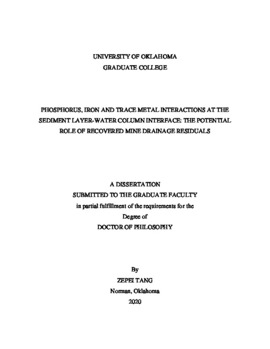| dc.contributor.advisor | Nairn, Robert | |
| dc.contributor.author | Tang, Zepei | |
| dc.date.accessioned | 2020-05-06T18:53:39Z | |
| dc.date.available | 2020-05-06T18:53:39Z | |
| dc.date.issued | 2020-05 | |
| dc.identifier.uri | https://hdl.handle.net/11244/324285 | |
| dc.description.abstract | Nutrient enrichment, eutrophication and harmful algal blooms are global environmental concerns. The study site, Grand Lake o’ the Cherokees (GLOC) located in northeast Oklahoma, experiences eutrophication due to excess phosphorus (P) loading and resulting severe algal blooms, and elevated sediment trace metal concentrations due to its close proximity to the abandoned Tri-State Lead-Zinc Mining District (TSMD). Mine Drainage Residuals (MDRs), amorphous iron oxyhydroxides recovered from passive treatment systems in the TSMD, may serve as phosphorus sinks for problems in GLOC. In order to understand metal-nutrient interactions at the sediment layer-water column interface at this reservoir and evaluate the P removal performance of MDR amendments, three green house microcosm (GHM) and one field mesocosm studies were conducted in this project.
The first GHM study (Chapter One) focused on impacts from algal blooms and showed that excessive biomass changed P balances between the water column and sediment layer, but did not impact trace metal concentrations in the system, which means that increased algal blooms in the reservoir likely will not result in trace metal release from contaminated sediments into the water column. The second GHM study (Chapter Two) investigated sediment disturbance effects and showed that mixing caused initial P release from sediment into the water column during resuspension, but overall P decreases after redeposition. Throughout the entire process, trace metal concentrations in both the water column and sediment layer were below the corresponding guidelines. The third GHM study (Chapter Three) compared P removal performance from different dosages of MDRs and showed no significant P decreases compared to control treatments in the short-term. However, significant P capture occurred with MDR addition treatments and the control treatments showed significant P release due to biomass death and decay. Overall, MDR additions served as long-term sinks for internal P loading to prevent labile P releases from biomass decay and decrease the likelihood of future blooms, all without noticeable trace metal release.
The field mesocosm study (Chapter Four) applied three different MDR addition methods (mixed, layered and bagged) and performance was compared to a control treatment. Although by the end of four months all four treatments achieved over 99% P removal, within the first seven days MDR addition treatments had much more rapid and greater P decreases than control due to the quicker P sorption rate and greater P sorption capacity than sediment (30 g/Kg compared to 0.6 g/Kg, respectively). No trace metal release was observed in both water and sediment, and the bagged MDR addition method was recommended for future engineering design of large-scale MDR amendments into eutrophic reservoirs to improve water quality and prevent harmful algal blooms. | en_US |
| dc.language | en_US | en_US |
| dc.subject | Phosphorus | en_US |
| dc.subject | Mine drainage residual | en_US |
| dc.subject | Tri-State Mining District | en_US |
| dc.subject | Sediment quality guideline | en_US |
| dc.subject.lcsh | Mines and mineral resources--Environmental aspects--Oklahoma | |
| dc.subject.lcsh | Mine drainage | |
| dc.subject.lcsh | Phosphorus | |
| dc.title | Phosphorus, Iron and Trace Metal Interactions at the Sediment Layer-Water Column Interface: The Potential Role of Recovered Mine Drainage Residuals | en_US |
| dc.contributor.committeeMember | Knox, Robert | |
| dc.contributor.committeeMember | Sabatini, David | |
| dc.contributor.committeeMember | Townsend, Darrell | |
| dc.contributor.committeeMember | Allen, Daniel | |
| dc.date.manuscript | 2020-05-03 | |
| dc.thesis.degree | Ph.D. | en_US |
| ou.group | Gallogly College of Engineering::School of Civil Engineering and Environmental Science | en_US |
| shareok.orcid | 0000-0002-9504-5812 | en_US |
| shareok.nativefileaccess | restricted | en_US |
